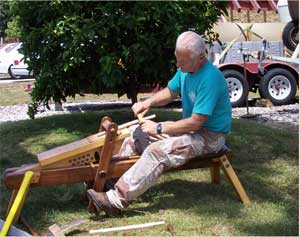
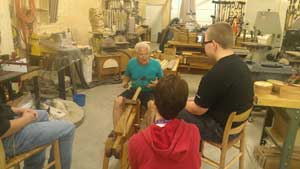 Russ Filbeck may have “officially” retired in 2010, but he doesn’t seem to be slowing down. Although he’s no longer a full-time teacher at Palomar College in California, he is still teaching woodworking there part-time as an adjunct professor, and spends much of the rest of his time volunteering his woodworking skills at the Good Samaritan Boys Ranch in Missouri and for the Carter Center.
Russ Filbeck may have “officially” retired in 2010, but he doesn’t seem to be slowing down. Although he’s no longer a full-time teacher at Palomar College in California, he is still teaching woodworking there part-time as an adjunct professor, and spends much of the rest of his time volunteering his woodworking skills at the Good Samaritan Boys Ranch in Missouri and for the Carter Center.
“I was a boy in trouble back in 1959, and the sheriff brought me here,” Russ said of the Good Samaritan Boys Ranch. “The Boys Ranch got me straightened out in life, and I went on to have a great career in the Navy and in submarines. Now I come back and help the boys get beyond their troubles and abuse and have a good life.”
Starting around the year 2000, Russ said, he began stopping by the ranch on his trips between California and Pennsylvania to get freshly cut cherry and walnut. “I would stop by and give money,” he said. “Then, in 2009, they had the 50th anniversary for the ranch. I missed it by a week. I was really disappointed I missed that. I told them then that I was a former resident, and I wanted to do things to help the boys.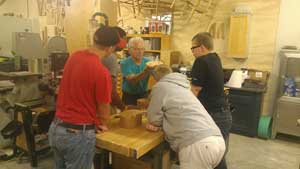
A few years ago, Russ set up a shop in the boys’ rec room, where he started teaching the process of chairmaking, as well as the construction of Shaker boxes. “Two or three years ago, the director said I needed a shop space,” Russ said. The ranch built a 24’ x 56’ shop building, and, this summer, will be pouring concrete to add a lumber storage room and a room for teaching “multiples”— whether that’s using several scroll saws at a time, or teaching a class that uses half a dozen lathes, instead of the two he keeps in the shop.
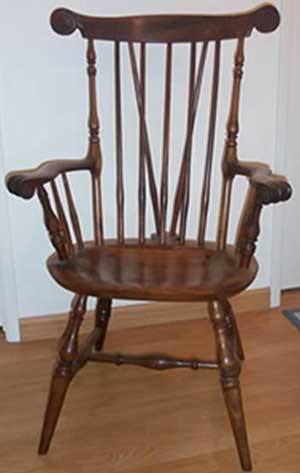 When setting up that shop, Russ said, “I went back to San Diego and told all my friends I needed their help to outfit the new building. My friends overwhelmed me with their generosity: it took one and a half semi trucks to haul all of it to the ranch. We brought it here on pallets.”
When setting up that shop, Russ said, “I went back to San Diego and told all my friends I needed their help to outfit the new building. My friends overwhelmed me with their generosity: it took one and a half semi trucks to haul all of it to the ranch. We brought it here on pallets.”
Russ’s friends also help him out in making items like pens and toys for the boys, who range in age from 10 to 17. “I like them to have a pen for writing letters home, and a spinning top so they can have a competition with their buddies to see whose top spins the longest. I like to make little toy race cars, particularly for the boys here when they come to the ranch with nothing but the clothes on their back.
“The race car, to me, is like a little Corvette,” Russ said. “They’re made out of different species, to give them some ideas about creativity. I don’t want the boys to say every time they see something, ‘Oh, I want that.’ I want them to say, ‘I want to learn how to make that.’ I want them to talk in terms of their own creativity, and not just ‘I want, I want, I want.’”
As for his own creativity, Russ is still very interested in chairmaking. The first chair he made was a Maloof style rocker back in 1982, which was “interesting and fun to do,” but what really sparked his interest was using a spokeshave and a drawing knife and making a chair by hand.
Drawing on the traditions of Appalachian-area chairmaking, particularly ladderback chairs, Russ learned more 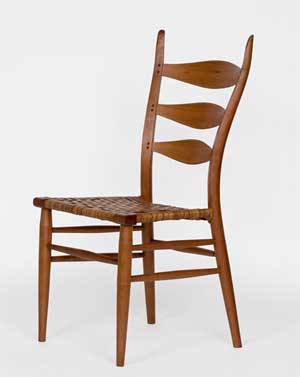 details from Brian Boggs. “It became an absolute obsession with me. I just had to tell other people about it,” Russ said. “Every chair I make, I can’t wait to sit on it for the first time. It’s never diminished.”
details from Brian Boggs. “It became an absolute obsession with me. I just had to tell other people about it,” Russ said. “Every chair I make, I can’t wait to sit on it for the first time. It’s never diminished.”
That passion for chairmaking has led to his offering chairmaking classes, to one student at a time, in weeklong sessions at his home shop. “We start Monday morning, and by Friday afternoon, they will have completed their chair.
“I cover the basics of how wood moves, how [the chair] is slatted, everything that’s connected. I want them to make a chair that will last for generations, so there’s a lot to be learned.”
For example, the rungs on the chairs assembled in these courses are kiln-dried, “so they shrink,” Russ said. “When you assemble them, the bone-dry tenon goes into a socket in the moist leg. Over time, the tenon will swell. I do use glue, but the shrinking of the leg and the swelling of the tenon creates a very strong mechanical joint.”
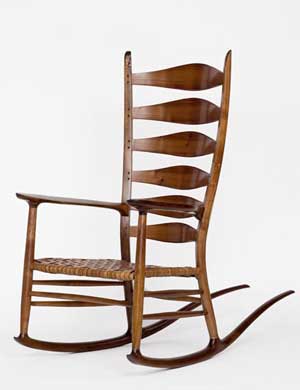 Russ has also written a book about Making Ladderback Chairs. Wanting to include a section on modern ladderback chair makers, he contacted some to see if they would be willing to describe their methods in the book. Among these was former U.S. President Jimmy Carter, who did end up contributing a portion to the book, describing how he makes chairs.
Russ has also written a book about Making Ladderback Chairs. Wanting to include a section on modern ladderback chair makers, he contacted some to see if they would be willing to describe their methods in the book. Among these was former U.S. President Jimmy Carter, who did end up contributing a portion to the book, describing how he makes chairs.
As a result of this initial connection, Russ ended up using a wooden spokeshave he had designed to be a better fit for wooden shaving horses to make a rocking chair for President Carter, which he delivered in June 2005.
“He gave me some of his books, and when I got back to San Diego and read them, one of them describes how he made ladderback chairs shortly after he left the White House and sold them through Sotheby’s auction house for seed money to start the Carter Center.
“I got back to him and said, if I made a replica of his chair that I made for him, it might do well in his auction,” now an annual event to help fund the Carter Center. “Then my wife told me that if you’re making something for him, you really ought to do something for his wife. So I made her a set of Shaker boxes.
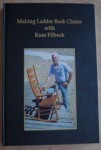
“Each year I have made a replica of his chair and her Shaker boxes and his spokeshave for auction. I’m pleased I have been able to help them quite a lot,” Russ said. He cited the health advocacy work of the Carter Center in regard to diseases such as guinea worm and river blindness as an area he particularly supports.
Russ now attends the auction – occurring June 25-29 this year, in Vail, Colorado – annually and spends about four days with the Carters every year. “We have a lot of things in common: he was a farm boy, and I was, too. We were both in the submarine service, and we both like to make ladderback chairs. We have a lot to talk about.”
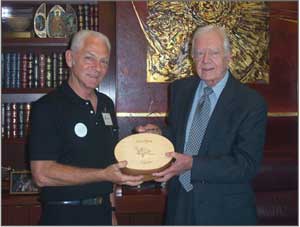 The Carters have also visited Russ at his shop, where “they wanted to see how I work. I demonstrated a lot for them, and they each made one Shaker box out of walnut and one out of cherry. I finished them for them, and laser engraved with their names – they signed them – and their Shaker boxes were also in the auction.”
The Carters have also visited Russ at his shop, where “they wanted to see how I work. I demonstrated a lot for them, and they each made one Shaker box out of walnut and one out of cherry. I finished them for them, and laser engraved with their names – they signed them – and their Shaker boxes were also in the auction.”
“It’s wonderful to be able to help using my woodworking skills,” Russ said. A couple of years ago, at the Good Samaritan Boys Ranch, “A boy asked me, ‘How do you feel when you leave here?’ I feel buoyant, almost like a balloon.”

“I don’t ever intend to retire,” Russ added. “I plan to keep making things until I can no longer stand upright. I’m 69, and President Carter is 89, but he’s so physically fit he does about everything he wants to do. I want to be like that.”






